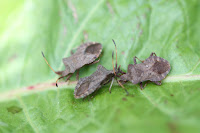 |
| Gorse Shield Bug |
It is very late October and the weather was pretty poor yesterday.
So, i wondered whether to carry my heavy camera on my daily dog walk. I once missed a picture of a Fritillary butterfly because I decided to leave it at home, so I rarely leave it behind.
 |
| Small Tortoiseshell |
And on the same piece of Gorse, was a Dock Bug.
Around the corner I came across a Small Tortoiseshell then heard the "pitchoo" call and saw a Marsh Tit. A bit too quick for a photograph, but not a bad couple of sightings for late October I thought.
 |
| Painted Lady |
 |
| Ivy Bee |
Further on I was looking forward to inspecting some stands of Ivy. Most are in flower with a few developing the red-black fruits so attractive the members of the Thrush family. The stands are in a south facing hedgerow and had been in full sun for most of the morning.
 |
| Comma |
 |
| Red Admiral |
I don't dare leave my camera behind now.



